 y.layout.AbstractLayoutStage
y.layout.AbstractLayoutStage
 y.layout.labeling.AbstractLabelingAlgorithm
y.layout.labeling.AbstractLabelingAlgorithm
 y.layout.labeling.MISLabelingAlgorithm
y.layout.labeling.MISLabelingAlgorithm
|
Search this API | ||||||||
| PREV CLASS NEXT CLASS | FRAMES NO FRAMES | ||||||||
| SUMMARY: NESTED | FIELD | CONSTR | METHOD | DETAIL: FIELD | CONSTR | METHOD | ||||||||
java.lang.Objecty.layout.AbstractLayoutStage
y.layout.labeling.AbstractLabelingAlgorithm
y.layout.labeling.MISLabelingAlgorithm
public abstract class MISLabelingAlgorithm
A base class for generic labeling algorithms which solve the labeling problem by reducing it to the maximum independent set (MIS) problem.
Different optimization strategies are available; an optimization strategy defines which criteria the algorithm should try to optimize. For example, reducing the number of overlaps between labels and nodes may be considered more important than reducing the number of overlaps between labels and edges.
GreedyMISLabeling,
SALabeling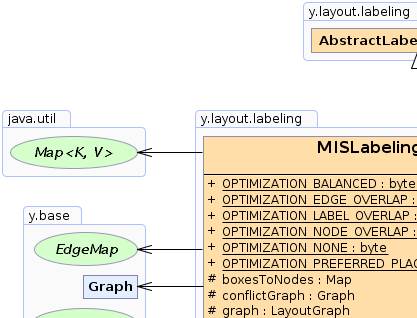 |
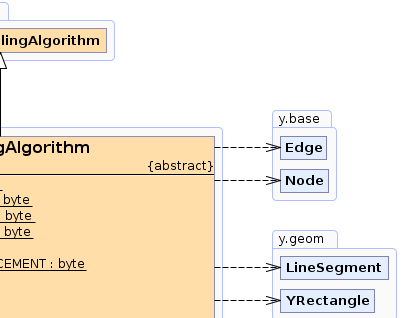 |
 |
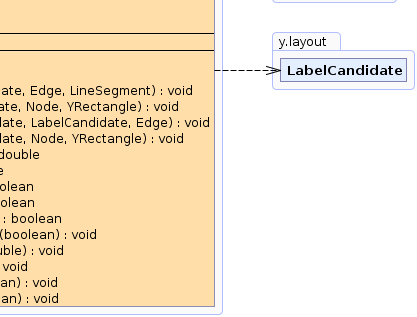 |
| Field Summary | |
|---|---|
protected java.util.Map |
boxesToNodes
The mapping from the LabelCandidates to the corresponding nodes in the conflictGraph. |
protected Graph |
conflictGraph
The conflict graph modeling LabelCandidates as nodes and edges between them as conflicts, i.e.,
overlaps among candidates. |
protected LayoutGraph |
graph
The input graph that will be labeled. |
protected NodeMap |
nodesToBoxes
The mapping from each node in the conflictGraph to the corresponding LabelCandidate instance. |
protected NodeMap |
nodesToID
The mapping from nodes in the conflictGraph to a corresponding integer value (ID). |
static byte |
OPTIMIZATION_BALANCED
An optimization strategy aiming at a good balance between the available optimization options. |
static byte |
OPTIMIZATION_EDGE_OVERLAP
An optimization strategy that especially reduces overlaps between labels and edges. |
static byte |
OPTIMIZATION_LABEL_OVERLAP
An optimization strategy that especially reduces overlaps between labels. |
static byte |
OPTIMIZATION_NODE_OVERLAP
An optimization strategy that especially reduces overlaps between labels and nodes as well as labels and node halos. |
static byte |
OPTIMIZATION_NONE
Use no optimization strategy. |
static byte |
OPTIMIZATION_PARTITION_GRID_OVERLAP
An optimization strategy that especially reduces overlaps of labels and the PartitionGrid. |
static byte |
OPTIMIZATION_PREFERRED_PLACEMENT
An optimization strategy that mainly tries to satisfy the preferences described by a PreferredPlacementDescriptor associated with edge labels. |
| Fields inherited from class y.layout.labeling.AbstractLabelingAlgorithm |
|---|
EPS, LABEL_MODEL_DPKEY, setCustomizedProfitModel |
| Fields inherited from interface y.layout.Layouter |
|---|
EDGE_ID_DPKEY, NODE_ID_DPKEY, NODE_TYPE_DPKEY, SELECTED_EDGES, SELECTED_NODES |
| Constructor Summary | |
|---|---|
protected |
MISLabelingAlgorithm()
Creates a new MISLabelingAlgorithm instance with default settings. |
| Method Summary | |
|---|---|
protected NodeMap |
assignProfit()
Returns a NodeMap which assigns a profit value to each node in the conflict graph. |
protected void |
createEdges()
Creates the edges in the conflict graph, i.e., one edge between two nodes if the corresponding LabelCandidates intersect. |
protected void |
foundEdgeOverlap(LabelCandidate labelCandidate,
Edge edge,
LineSegment eSegment)
Indicates that an overlap between a LabelCandidate and an Edge of the input graph has been found. |
protected void |
foundHaloOverlap(LabelCandidate labelCandidate,
Node node,
YRectangle haloRect)
Indicates that an overlap between a LabelCandidate and a NodeHalo of the input graph has been found. |
protected void |
foundLabelOverlap(LabelCandidate candidate1,
LabelCandidate candidate2,
Edge edge)
Indicates that an overlap between two LabelCandidates has been found. |
protected void |
foundNodeOverlap(LabelCandidate labelCandidate,
Node node,
YRectangle nodeBox)
Indicates that an overlap between a LabelCandidate and a Node of the input graph has been found. |
protected void |
foundPartitionGridInsetOverlap(LabelCandidate labelCandidate,
YRectangle insetBox)
Indicates that an overlap between a LabelCandidate and the insets of a cell of the PartitionGrid has been found. |
protected void |
foundPartitionGridInteriorOverlap(LabelCandidate labelCandidate,
YRectangle partitionGridBounds)
Indicates that the LabelCandidate is inside of the PartitionGrid. |
protected void |
foundPartitionGridLineOverlap(LabelCandidate labelCandidate,
LineSegment lineSegment)
Indicates that an overlap between a LabelCandidate and the PartitionGrid has been found. |
double |
getCustomProfitModelRatio()
Returns the ratio between the internal profit (ip) and the profit computed using the specified profit model (sp). |
byte |
getOptimizationStrategy()
Returns the optimization strategy which defines the importance of criteria when optimizing labeling results. |
boolean |
getRemoveEdgeOverlaps()
Returns whether or not label candidates that overlap with edges are removed. |
boolean |
getRemoveNodeOverlaps()
Returns whether or not label candidates that overlap with nodes are removed. |
boolean |
isAmbiguityReductionEnabled()
Returns whether or not the number of ambiguous label placements is reduced by applying an additional optimization step. |
void |
setAmbiguityReductionEnabled(boolean ambiguityReductionEnabled)
Specifies whether or not the number of ambiguous label placements is reduced by applying an additional optimization step. |
void |
setCustomProfitModelRatio(double customProfitModelRatio)
Specifies the ratio between the internal profit (ip) and the profit computed using the specified profit model (sp). |
void |
setOptimizationStrategy(byte optimizationStrategy)
Specifies the optimization strategy which defines the importance of criteria when optimizing labeling results. |
void |
setRemoveEdgeOverlaps(boolean flag)
Specifies whether or not label candidates that overlap with edges are removed. |
void |
setRemoveNodeOverlaps(boolean flag)
Specifies whether or not label candidates that overlap with nodes are removed. |
| Methods inherited from class y.layout.AbstractLayoutStage |
|---|
canLayoutCore, doLayoutCore, getCoreLayouter, setCoreLayouter |
| Methods inherited from class java.lang.Object |
|---|
clone, equals, finalize, getClass, hashCode, notify, notifyAll, toString, wait, wait, wait |
| Field Detail |
|---|
public static final byte OPTIMIZATION_BALANCED
setOptimizationStrategy(byte),
Constant Field Valuespublic static final byte OPTIMIZATION_NODE_OVERLAP
setOptimizationStrategy(byte),
Constant Field Valuespublic static final byte OPTIMIZATION_LABEL_OVERLAP
setOptimizationStrategy(byte),
Constant Field Valuespublic static final byte OPTIMIZATION_EDGE_OVERLAP
setOptimizationStrategy(byte),
Constant Field Valuespublic static final byte OPTIMIZATION_PREFERRED_PLACEMENT
PreferredPlacementDescriptor associated with edge labels.
setOptimizationStrategy(byte),
Constant Field Valuespublic static final byte OPTIMIZATION_PARTITION_GRID_OVERLAP
PartitionGrid.
This strategy tries to avoid label positions that intersect with the grid lines themselves, and to a lesser case
the insets of the grid. Placement completely outside of the grid bounds is also avoided more strictly.
Note that this optimization relies on the original positions of the RowDescriptor and
ColumnDescriptor. If the labeling algorithm is used standalone and a previous layout run
has modified the partition grid, the original values may be out of date and the computed values need to be
written back manually.
setOptimizationStrategy(byte),
Constant Field Valuespublic static final byte OPTIMIZATION_NONE
protected LayoutGraph graph
protected Graph conflictGraph
LabelCandidates as nodes and edges between them as conflicts, i.e.,
overlaps among candidates.
createEdges()protected NodeMap nodesToBoxes
conflictGraph to the corresponding LabelCandidate instance.
conflictGraphprotected java.util.Map boxesToNodes
LabelCandidates to the corresponding nodes in the conflictGraph.
conflictGraphprotected NodeMap nodesToID
conflictGraph to a corresponding integer value (ID). The ID
denotes the actual label which a LabelCandidate (i.e. a node in the conflict graph) belongs to.
| Constructor Detail |
|---|
protected MISLabelingAlgorithm()
MISLabelingAlgorithm instance with default settings.
| Method Detail |
|---|
public double getCustomProfitModelRatio()
profit model (sp).
This ratio defines how to weight the two profit values (ip) and (sp).
The overall ratio is then computed as ratio * sp + (1 - ratio) * ip.
The profit of a LabelCandidate defines how likely it is that the candidate will
be chosen as actual label position.
The ratio is defined to be a value from the interval [0,1].
profit model is null or
if OPTIMIZATION_NONE is chosen as optimization strategy.[0,1]) between the internal profit
and the profit calculated using the current profit modelsetCustomProfitModelRatio(double)public void setCustomProfitModelRatio(double customProfitModelRatio)
profit model (sp).
This ratio defines how to weight the two profit values (ip) and (sp).
The overall ratio is then computed as ratio * sp + (1 - ratio) * ip.
The profit of a LabelCandidate defines how likely it is that the candidate will
be chosen as actual label position.
The ratio is defined to be a value from the interval [0,1].
profit model is null or
if OPTIMIZATION_NONE is chosen as optimization strategy.customProfitModelRatio - the ratio (from the interval [0,1]) between the internal profit
and the profit calculated using the current profit model
java.lang.IllegalArgumentException - if the given ratio is negative or larger than 1AbstractLabelingAlgorithm.setProfitModel(ProfitModel),
setOptimizationStrategy(byte)public byte getOptimizationStrategy()
Depending on the strategy, criteria like label-node overlaps, label-label overlaps and others are
more or less important. For example, if the number of overlaps between labels and nodes is the most important
criterion for the result, strategy OPTIMIZATION_NODE_OVERLAP should be chosen.
optimization step.setOptimizationStrategy(byte)public void setOptimizationStrategy(byte optimizationStrategy)
Depending on the strategy, criteria like label-node overlaps, label-label overlaps and others are
more or less important. For example, if the number of overlaps between labels and nodes is the most important
criterion for the result, strategy OPTIMIZATION_NODE_OVERLAP should be chosen.
optimization step.OPTIMIZATION_BALANCEDoptimizationStrategy - one of the predefined optimization strategies
java.lang.IllegalArgumentException - if the given strategy is unknownpublic void setRemoveNodeOverlaps(boolean flag)
label candidates that overlap with nodes are removed.
If overlapping candidates are not removed, they will be considered but get a penalty. Therefore, it is still less likely that an overlapping candidate is finally chosen.
The detection and removal of labels that overlap with nodes may increase the runtime of this algorithm.
setRemoveNodeOverlaps in class AbstractLabelingAlgorithmNodeLabelModel.getDefaultParameter() for node labels
and EdgeLabelModel.getDefaultParameter() for edge labels).OPTIMIZATION_NONE
set as optimization strategy, i.e., without optimization.
If used together with optimization, the optimization strategy may be restricted too much
and not deliver as good results as it could otherwise do.flag - true if candidates overlapping with nodes should be removed,
false otherwise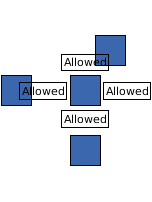 false - all four candidate positions are allowed, even though two are overlapping | 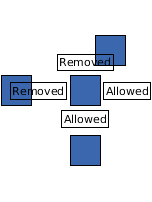 true - the candidate position left and above the node are overlapping and thus removed |
public boolean getRemoveNodeOverlaps()
label candidates that overlap with nodes are removed.
If overlapping candidates are not removed, they will be considered but get a penalty. Therefore, it is still less likely that an overlapping candidate is finally chosen.
The detection and removal of labels that overlap with nodes may increase the runtime of this algorithm.
getRemoveNodeOverlaps in class AbstractLabelingAlgorithmNodeLabelModel.getDefaultParameter() for node labels
and EdgeLabelModel.getDefaultParameter() for edge labels).OPTIMIZATION_NONE
set as optimization strategy, i.e., without optimization.
If used together with optimization, the optimization strategy may be restricted too much
and not deliver as good results as it could otherwise do.true if candidates overlapping with nodes are removed,
false otherwisesetRemoveNodeOverlaps(boolean)public void setRemoveEdgeOverlaps(boolean flag)
label candidates that overlap with edges are removed.
If overlapping candidates are not removed, they will be considered but get a penalty. Therefore, it is still less likely that an overlapping candidate is finally chosen.
The detection and removal of labels that overlap with edges may increase the runtime of this algorithm.
setRemoveEdgeOverlaps in class AbstractLabelingAlgorithmNodeLabelModel.getDefaultParameter() for node labels
and EdgeLabelModel.getDefaultParameter() for edge labels).OPTIMIZATION_NONE
set as optimization strategy, i.e., without optimization.
If used together with optimization, the optimization strategy may be restricted too much
and not deliver as good results as it could otherwise do.flag - true if candidates overlapping with edges should be removed,
false otherwise false - all four candidate positions are allowed |  true - only two of the four candidate positions are allowed, the others will be removed |
public boolean getRemoveEdgeOverlaps()
label candidates that overlap with edges are removed.
If overlapping candidates are not removed, they will be considered but get a penalty. Therefore, it is still less likely that an overlapping candidate is finally chosen.
The detection and removal of labels that overlap with edges may increase the runtime of this algorithm.
getRemoveEdgeOverlaps in class AbstractLabelingAlgorithmNodeLabelModel.getDefaultParameter() for node labels
and EdgeLabelModel.getDefaultParameter() for edge labels).OPTIMIZATION_NONE
set as optimization strategy, i.e., without optimization.
If used together with optimization, the optimization strategy may be restricted too much
and not deliver as good results as it could otherwise do.true if candidates overlapping with edges are removed,
false otherwisesetRemoveEdgeOverlaps(boolean)public boolean isAmbiguityReductionEnabled()
A label position is considered to be ambiguous if it might not be possible to identify to which graph element the label belongs. For example, an edge label placed in between two edges is ambiguous.
Enabling this reduction step does not guarantee that no ambiguous placements are selected.
The algorithm will try to avoid them if other good positions without ambiguity are available.
Other aspects like preferred placement for
edge labels will still be more important than the reduction of ambiguity.
LabelCandidates.OPTIMIZATION_NONE is selected as
optimization strategy.true if the algorithm tries to avoid ambiguous label placements,
false otherwisesetAmbiguityReductionEnabled(boolean)public void setAmbiguityReductionEnabled(boolean ambiguityReductionEnabled)
A label position is considered to be ambiguous if it might not be possible to identify to which graph element the label belongs. For example, an edge label placed in between two edges is ambiguous.
Enabling this reduction step does not guarantee that no ambiguous placements are selected.
The algorithm will try to avoid them if other good positions without ambiguity are available.
Other aspects like preferred placement for
edge labels will still be more important than the reduction of ambiguity.
LabelCandidates.OPTIMIZATION_NONE is selected as
optimization strategy.ambiguityReductionEnabled - true if the algorithm should try to avoid ambiguous label placements,
false otherwiseprotected void createEdges()
LabelCandidates intersect.
The nodes of the conflict graph represent LabelCandidates. An edge between
candidates signals that they overlap. A maximum independent set will be computed on the conflict graph
to choose candidates such that no two candidates overlap.
This method may be overridden to change the structure of the conflict graph.
Edges between two LabelCandidates in the conflict graph signal that the two candidates should
not be selected together. By overriding this method, arbitrary reasons for indicating that two label
candidates should not be chosen at the same time can be modeled.
foundEdgeOverlap(LabelCandidate, Edge, LineSegment),
foundHaloOverlap(LabelCandidate, Node, YRectangle),
foundLabelOverlap(LabelCandidate, LabelCandidate, Edge) and
foundNodeOverlap(LabelCandidate, Node, YRectangle) will be invoked when finding
an intersection of a certain type. The mentioned methods will influence the
profit of label candidates. This should be kept in mind
when overriding this method.conflictGraph,
nodesToBoxes,
boxesToNodes,
nodesToIDprotected NodeMap assignProfit()
NodeMap which assigns a profit value to each node in the conflict graph.
As the conflict graph's nodes represent LabelCandidates, this mapping gives the
profit value of label candidates. The assigned value is defined as
the difference between the profit induced by the profit model
and the candidate's overlap penalty.
The returned map is a mapping from each Node (representing a label candidate) in the
conflictGraph to a Double representing the profit value of the candidate.
protected void foundLabelOverlap(LabelCandidate candidate1,
LabelCandidate candidate2,
Edge edge)
LabelCandidates has been found.
This method is called when finding overlaps while creating edges of the
conflict graph. It will store a factor indicating how much the two candidates
overlap. The factor influences the penalty assigned when both candidates are chosen, i.e., the
penalty for the corresponding overlap.
This method may be overridden to realize a custom strategy for reacting to overlaps among
LabelCandidates.
OPTIMIZATION_NONE is chosen as
optimization strategy.candidate1 - the first overlapping LabelCandidatecandidate2 - the second overlapping LabelCandidateedge - the Edge in conflictGraph representing the found overlapconflictGraph,
createEdges()
protected void foundNodeOverlap(LabelCandidate labelCandidate,
Node node,
YRectangle nodeBox)
LabelCandidate and a Node of the input graph has been found.
This method is called when finding overlaps while creating edges of the
conflict graph. It will store a factor indicating how much the two elements
overlap. The factor influences the profit assigned to the given
label candidate.
This method may be overridden to realize a custom strategy for reacting to overlaps between label candidates and nodes.
OPTIMIZATION_NONE is chosen as
optimization strategy.labelCandidate - the LabelCandidate overlapping with the given nodenode - the Node overlapping with the given label candidatenodeBox - the bounding box of the given nodeconflictGraph,
createEdges()
protected void foundEdgeOverlap(LabelCandidate labelCandidate,
Edge edge,
LineSegment eSegment)
LabelCandidate and an Edge of the input graph has been found.
This method is called when finding overlaps while creating edges of the
conflict graph. It will store a factor indicating how much the two elements
overlap. The factor influences the profit assigned to the given
label candidate.
This method may be overridden to realize a custom strategy for reacting to overlaps between label candidates and edges.
OPTIMIZATION_NONE is chosen as
optimization strategy.labelCandidate - the LabelCandidate overlapping with the given Edgeedge - the Edge overlapping with the given LabelCandidateeSegment - the LineSegment of the given edge overlapping with the given candidateconflictGraph,
createEdges()
protected void foundHaloOverlap(LabelCandidate labelCandidate,
Node node,
YRectangle haloRect)
LabelCandidate and a NodeHalo of the input graph has been found.
This method is called when finding overlaps while creating edges of the
conflict graph. It will store a factor indicating how much the two elements
overlap. The factor influences the profit assigned to the given
label candidate.
This method may be overridden to realize a custom strategy for reacting to overlaps between label candidates and node halos.
OPTIMIZATION_NONE is chosen as
optimization strategy.labelCandidate - the LabelCandidate overlapping with a node halonode - the Node whose NodeHalo is overlapping with the given label candidatehaloRect - the bounding box of the NodeHalo overlapping with the given label candidateconflictGraph,
createEdges()
protected void foundPartitionGridLineOverlap(LabelCandidate labelCandidate,
LineSegment lineSegment)
LabelCandidate and the PartitionGrid has been found.
This method is called when finding overlaps of label candidates and lines of the partition grid.
It will store a factor indicating how much the two elements overlap. The factor influences
the profit assigned to the given label candidate.
This method may be overridden to realize a custom strategy for reacting to overlaps between label candidates and partition grid lines.
OPTIMIZATION_NONE is chosen as
optimization strategy.labelCandidate - the LabelCandidate overlapping with the PartitionGridlineSegment - a LineSegment of the PartitionGrid that is overlapping with the given label candidateconflictGraph
protected void foundPartitionGridInsetOverlap(LabelCandidate labelCandidate,
YRectangle insetBox)
LabelCandidate and the insets of a cell of the PartitionGrid has been found.
This method is called when finding overlaps of label candidates and insets of the partition grid.
It will store a factor indicating how much the two elements overlap. The factor influences
the profit assigned to the given label candidate.
This method may be overridden to realize a custom strategy for reacting to overlaps between label candidates and partition grid insets.
OPTIMIZATION_NONE is chosen as
optimization strategy.labelCandidate - the LabelCandidate overlapping with the PartitionGridinsetBox - a YRectangle representing an inset region of the PartitionGrid that is
overlapping with the given label candidateconflictGraph
protected void foundPartitionGridInteriorOverlap(LabelCandidate labelCandidate,
YRectangle partitionGridBounds)
LabelCandidate is inside of the PartitionGrid.
This method is called when the given LabelCandidate lies inside the partition grid.
It will store a factor indicating how much the two elements overlap. The factor influences
the profit assigned to the given label candidate.
This method may be overridden to realize a custom strategy for reacting to overlaps between label candidates and the partition grid.
LabelCandidate is typically preferred to lie
inside the partition grid area.labelCandidate - the LabelCandidate overlapping with the PartitionGridpartitionGridBounds - a YRectangle representing the bounds of the PartitionGridconflictGraph
|
© Copyright 2000-2025, yWorks GmbH. All rights reserved. |
||||||||
| PREV CLASS NEXT CLASS | FRAMES NO FRAMES | ||||||||
| SUMMARY: NESTED | FIELD | CONSTR | METHOD | DETAIL: FIELD | CONSTR | METHOD | ||||||||